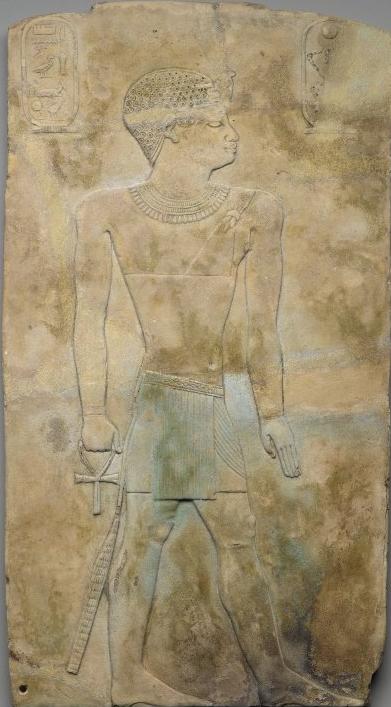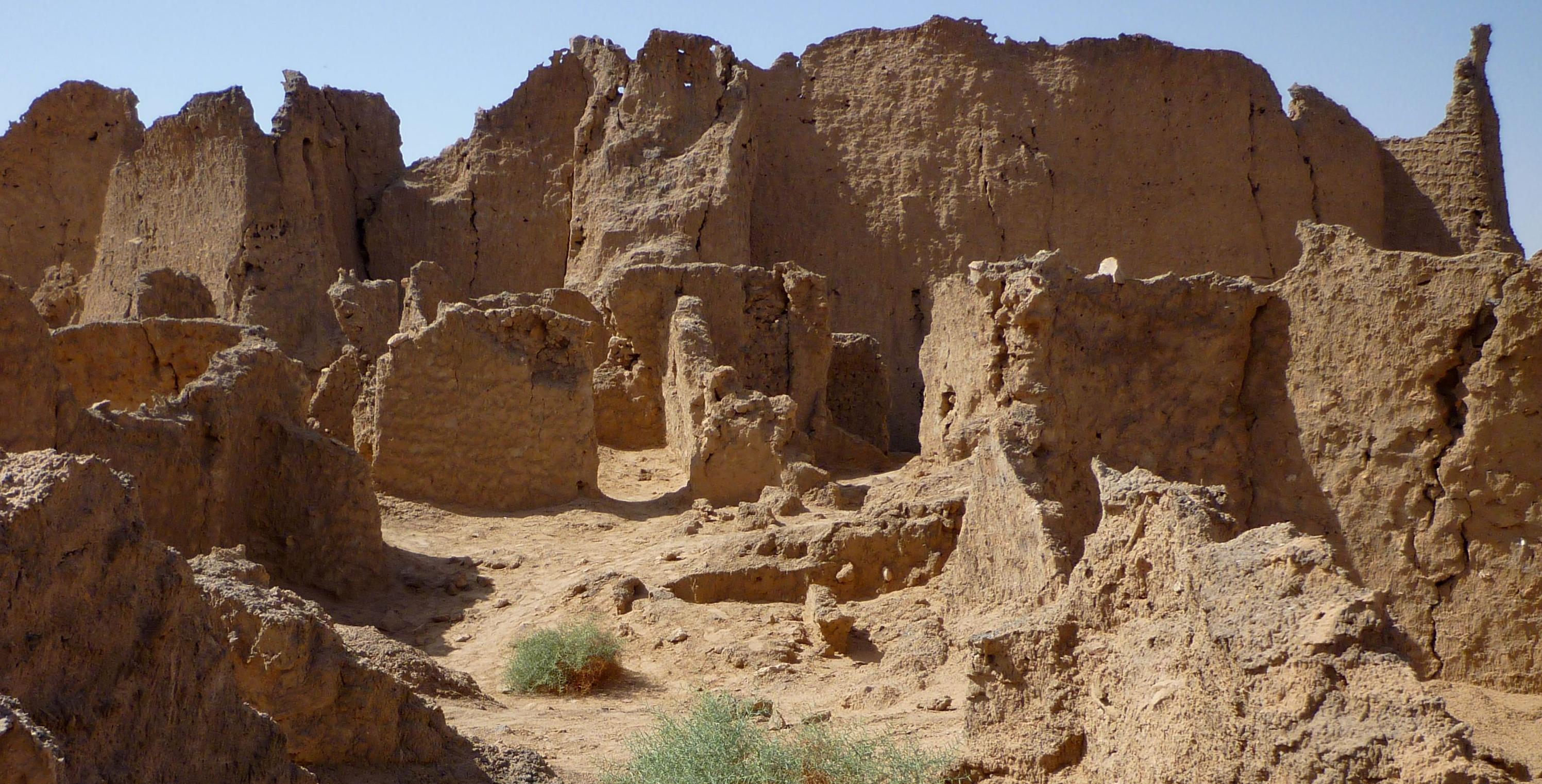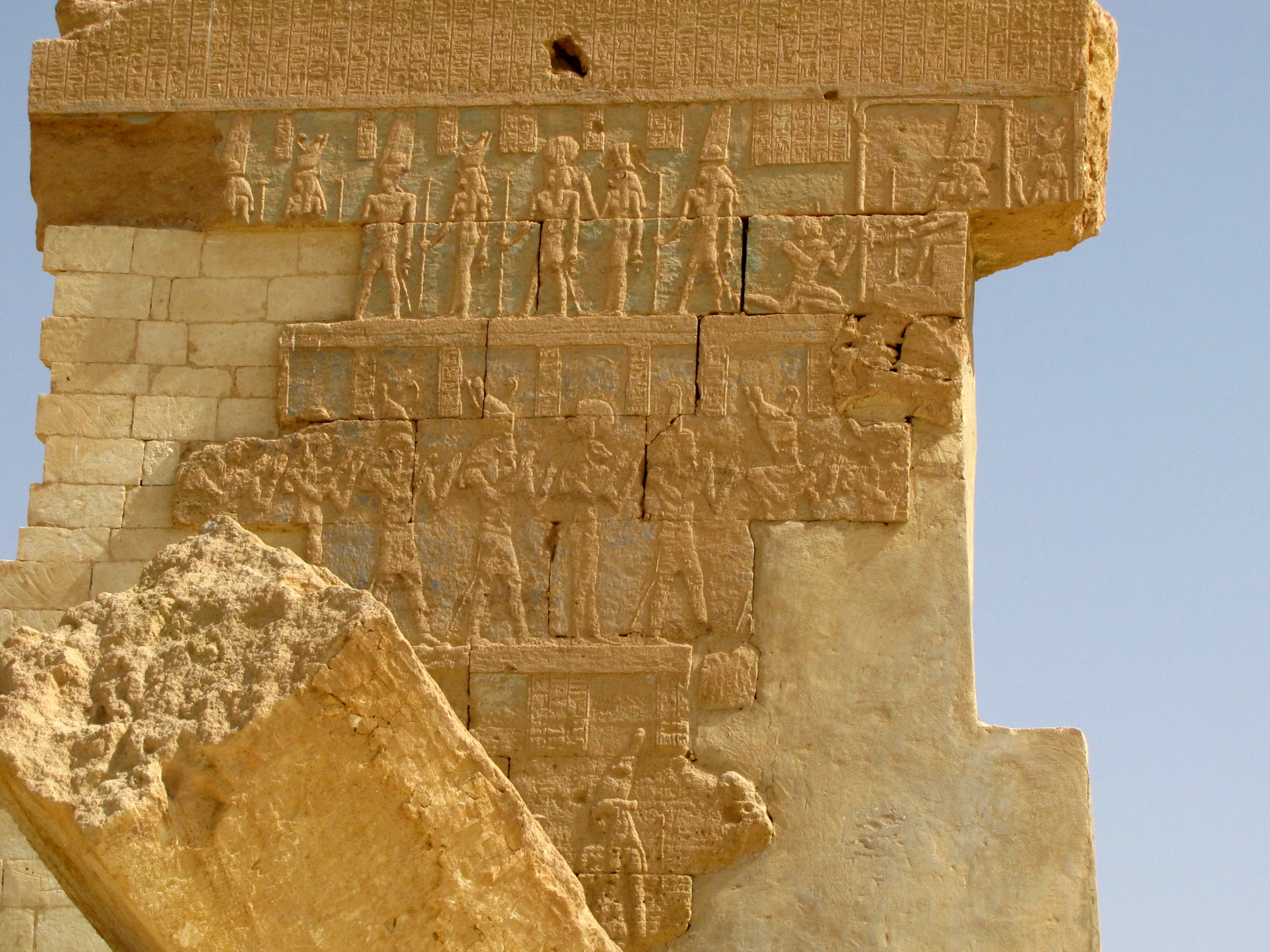Ancient Libya
Etymology
The name "Libya" derives from the Medu Neter name "LBW," which the ancient Ta Merrians (Egyptians and Thebans) used when referring to an organized country located somewhere west of the Nile Valley.
Libya was first mentioned in the 12th dynasty (1991-1786 BC) "Prophecy of Neferti," a historical story that takes place during the reign
of the 4th dynasty suten (pharoah) Sneferu (c. 2550 BC):
"Then a king will come from the South,
Ameny, the justified, my name,
Son of a woman of Ta-Seti, child of Upper Egypt,
He will take the white crown,
he will join the Two Mighty Ones (the two crowns).
Asiatics will fall to his sword,
Libyans will fall to his flame,
Rebels to his wrath, traitors to his might,
As the serpent on his brow subdues the rebels for him,
One will build the Walls-of-the-Ruler,
To bar Asiatics from entering Egypt..."
Ancient Greek colonists in Cyrene, a coastal city located northwest of the Nile delta, used the Greek word Λ ιβυη
or Libue to refer to this region.
A stele depicting Iuput II, Libyan governor of Taremu in the Nile Delta (c. 728 B.C.), housed in the Brookyln Museum
 |
Libyans in Dynastic Ta-Merrian History
Libyans are mentioned in the historical text, called the Victory Stele of Merneptah (c. 1215 BC, 19th dynasty):
"Woe to Libyans, they have ceased to live In the good manner of
roaming the field; in a single day their stride was halted in a single
year were the Tjehenu burned! Seth turned his back upon their chief,
By his word their villages were ruined; there's no work of carrying
[loads] these days. Hiding is useful, it's safe in the cave. The great
Lord of Egypt, might and strength are his. Who will combat, knowing
how he strides? A witless fool is he who takes him on, he knows no
tomorrow who attacks his border!"
During the fall of Ta-Merrian civilization, Libyans rose to prominance in the Nile Valley. The so-called 22nd dynasty consisted of Libyans and reigned
in the north from Djanet (Tanis) from 943 to 716 BC. The 23rd dynasty (880-724 BC) was another Libyan dynasty that
controlled a portion of the Nile between the cities of Hutnenesu (Herakleopolis)
and Gebtu (Coptos) at roughly the same time. After the much shorter 24th
dynasty fell, the Napatan (Kushitic or Ethiopian) suten Piye made Iuput II the governor of the northern city of Taremu (Leontopolis).
Libya According to the Greeks:
Greek historian and traveller, Herodotus (484-425 BC), like other ancient Greek writers, referred to all of Africa as
Libya, saying,
"As for Libya, we know
it to be washed on all sides by the sea, except where it is attached to Asia."
Herotodus also described in detail the inhabitants of Libya and identified several distinctive groups, as
related to him by the Carthaginians:
Adyrmachidae:
"The Libyans dwell in the order which I will now describe. Beginning on the side of Egypt, the first Libyans are the Adyrmachidae. These people
have, in most points, the same customs as the Egyptians, but use the costume of the Libyans. Their women wear on each leg a ring made of bronze;
they let their hair grow long, and when they catch any vermin on their persons, bite it and throw it away. In this they differ from all the other
Libyans. They are also the only tribe with whom the custom obtains of bringing all women about to become brides before the king, that he may
choose such as are agreeable to him. The Adyrmachidae extend from the borders of Egypt to the harbor called Port Plynus."
Gilligammae:
"Next to the Adyrmachidae are the Gilligammae, who inhabit the country westward as far as the island of Aphrodisias...The customs of the Gilligammae are like those of the rest of their countrymen."
Cyrenaens:
"The country of the Cyrenaeans, which is the highest tract within the
part of Libya inhabited by the wandering tribes, has
three seasons that deserve remark. And the harvest-time of the
Cyrenaeans continues thus for eight full months...Off this tract is the island of Platea, which the Cyrenaeans colonized. Here too, upon the mainland, are Port Menelaus, and Aziris, where the Cyrenaeans once lived."
Asbystae:
"The Asbystae adjoin the Gilligammae upon the west. They inhabit the regions above Cyrene, but do not reach to the coast... Four-horse chariots are in more common use among them than among any other Libyans."
Auschisae, Cabalians and Barcaeans:
"Westward of the Asbystae dwell the Auschisae, who possess the country above Barca, reaching, however, to the sea at the place called Euesperides.
In the middle of their territory is the little tribe of the Cabalians, which touches the coast near Tauchira, a city of the Barcaeans. Their
customs are like those of the Libyans above Cyrene."
Nasamonians:
"The Nasamonians, a numerous people, are the western neighbors of the Auschisae. In summer they leave their flocks and herds upon the sea-shore,
and go up the country to a place called Augila, where they gather the dates from the palms, which in those parts grow thickly, and are of great
size, all of them being of the fruit-bearing kind.... The following are their customs in the swearing of oaths and the practice of augury.
The man, as he swears, lays his hand upon the tomb of some one considered to have been pre-eminently just and good, and so doing swears by his
name. For divination they betake themselves to the sepulchers of their own ancestors, and, after praying, lie down to sleep upon their graves;
by the dreams which then come to them they guide their conduct. When they pledge their faith to one another, each gives the other to drink out
of his hand; if there be no liquid to be had, they take up dust from the ground, and put their tongues to it...
Next to the Ammonians, at the distance of ten days' journey along the ridge of sand, there is a second salt-hill like the Ammonian, and a
second spring. The country round is inhabited, and the place bears the name of Augila. Hither it is that the Nasamonians come to gather in
the dates."
Psylli:
"On the country of the Nasamonians borders that of the Psylli, who were swept away under the following circumstances. The south-wind had blown
for a long time and dried up all the tanks in which their water was stored. Now the whole region within the Syrtis is utterly devoid of springs.
Accordingly the Psylli took counsel among themselves, and by common consent made war upon the southwind---so at least the Libyans say, I do but
repeat their words---they went forth and reached the desert; but there the south-wind rose and buried them under heaps of sand: whereupon, the
Psylli being destroyed, their lands passed to the Nasamonians."
Garamantians:
"Above the Nasamonians, towards the south, in the district where the wild beasts abound, dwell the Garamantians, who avoid all society or
intercourse with their fellow-men, have no weapon of war, and do not know how to defend themselves. These border the Nasamonians on the south...
Ten days' journey from Augila there is again a salt-hill and a spring; palms of the fruitful kind grow here abundantly, as they do also at the other salt-hills.
This region is inhabited by a nation called the Garamantians, a very powerful people, who cover the salt with mold, and then sow their crops.
From thence is the shortest road to the Lutophagi, a journey of thirty days. In the Garamantian country are found the oxen which, as they graze,
walk backwards. This they do because their horns curve outwards in front of their heads, so that it is not possible for them when grazing to
move forwards, since in that case their horns would become fixed in the ground. Only herein do they differ from other oxen, and further in the
thickness and hardness of their hides. The Garamantians have four-horse chariots, in which they chase the Troglodyte Ethiopians..."
The ruins of the ancient city of Garama, the capital of the Garamantians in modern-day Libya (courtesy of Franzfoto)
 |
Altarantians:
"At the distance of ten days' journey from the Garamantians there is again another salt-hill and spring of water; around which dwell a people,
called the Atarantians, who alone of all known nations are destitute of names. The title of Atarantians is borne by the whole race in common;
but the men have no particular names of their own. The Atarantians, when the sun rises high in the heaven, curse him, and load him with
reproaches, because (they say) he burns and wastes both their country and themselves."
Atlanteans:
"As far as the Atlantes the names of the nations inhabiting the sandy ridge are known to me; but beyond them my knowledge fails. The ridge
itself extends as far as the Pillars of Hercules, and even further than these; and throughout the whole distance, at the end of every ten
days' there is a salt-mine, with people dwelling round it who all of them build their houses with blocks of the salt. No rain falls in
these parts of Libya; if it were otherwise, the walls of these houses could not stand. The salt quarried is of two colors, white and purple.
Beyond the ridge, southwards, in the direction of the interior, the country is a desert, with no springs, no beasts, no rain, no wood, and
altogether destitute of moisture."
Macea:
"westward along the sea-shore their neighbors are the Macea, who, by letting the locks about the crown of their head grow long, while they
clip them close everywhere else, make their hair resemble a crest. In war these people use the skins of ostriches for shields. The river
Cinyps rises among them from the height called "the Hill of the Graces," and runs from thence through their country to the sea. The Hill
of the Graces is thickly covered with wood, and is thus very unlike the rest of Libya, which is bare. It is distant two hundred furlongs
from the sea."
Gindanes:
"Adjoining the Macae are the Gindanes, whose women wear on their legs anklets of leather. Each lover that a woman has gives her one; and she who
can show the most is the best esteemed, as she appears to have been loved by the greatest number of men."
Lotophagi:
"A promontory jutting out into the sea from the country of the Gindanes is inhabited by the Lotophagi, who live entirely on the fruit of the
lotus-tree. The lotus fruit is about the size of the lentisk berry, and in sweetness resembles the date. The Lotophagi even succeed in
obtaining from it a sort of wine."
Machlyans:
"The sea-coast beyond the Lotophagi is occupied by the Machlyans, who use the lotus to some extent, though not so much as the people of whom we last spoke.
The Machlyans reach as far as the great river called the Triton, which empties itself into the great lake Tritonis. Here, in this lake, is an
island called Phla, which it is said the Lacedaemonians were to have colonized, according to an oracle."
Auseans:
"The next tribe beyond the Machlyans is the tribe of the Auseans. Both these nations inhabit the borders of Lake Tritonis, being separated from
one another by the river Triton. Both also wear their hair long, but the Machlyans let it grow at the back of the head, while the Auseans
have it long in front. The Ausean maidens keep year by year a feast in honor of Minerva, whereat their custom is
to draw up in two bodies, and fight with stones and clubs. They say that these are rites which have come down to them from their fathers, and
that they honor with them their native goddess, who is the same as the Minerva (Athena) of the Grecians. If any of the maidens die of the wounds
they receive, the Auseans declare that such are false maidens. Before the fight is suffered to begin, they have another ceremony. One of the
virgins, the loveliest of the number, is selected from the rest; a Corinthian helmet and a complete suit of Greek armor are publicly put upon
her; and, thus adorned, she is made to mount into a chariot, and led around the whole lake in a procession. What arms they used for the
adornment of their damsels before the Greeks came to live in their country, I cannot say. I imagine they dressed them in Egyptian armor, for
I maintain that both the shield and the helmet came into Greece from Egypt. The Auseans declare that Minerva is the daughter of Neptune and
the Lake Tritonis---they say she quarreled with her father, and applied to Jupiter, who consented to let her be his child; and so she became
his adopted daughter. These people do not marry or live in families, but dwell together like the gregarious beasts. When their children are
full-grown, they are brought before the assembly of the men, which is held every third month, and assigned to those whom they most resemble."
Ammonians:
"Above them inland is the wild-beast tract: and beyond that, a ridge of sand, reaching from Egyptian Thebes to the Pillars of Hercules.
Throughout this ridge, at the distance of about ten days' journey from one another, heaps of salt in large lumps lie upon hills. At the
top of every hill there gushes forth from the middle of the salt a stream of water, which is both cold and sweet. Around dwell men who
are the last inhabitants of Libya on the side of the desert, living, as they do, more inland than the wild-beast district. Of these nations
the first is that of the Ammonians, who dwell at a distance of ten days' from Thebes [Waset], and have a temple derived from that of the
Theban Jupiter [Amun]. For at Thebes likewise, as I mentioned above, the image of Jupiter has a face like that of a ram. The Ammonians have another
spring besides that which rises from the salt. The water of this stream is lukewarm at early dawn; at the time when the market fills it is
much cooler; by noon it has grown quite cold; at this time, therefore, they water their gardens. As the afternoon advances the coldness goes
off, till, about sunset, the water is once more lukewarm; still the heat increases, and at midnight it boils furiously. After this time it
again begins to cool, and grows less and less hot till morning comes. This spring is called 'the Fountain of the Sun.'"
"Therefore the Egyptians give their statues of Jupiter the face of a ram: and from them the practice has passed to the
Ammonians [Siwa Owasis], who are a joint colony of Egyptians and Ethiopians, speaking a language between the two; hence also, in my
opinion, the latter people took their name of Ammonians , since the Egyptian name for Jupiter is Amun."
A relief from an ancient Temple of Amun in Umm Ubayda on the Siwa Oasis, the home of the so-called Ammonians (built by Nectanebo II, 360?342 B.C.)
 |
Maxyans:
"Westward of the river Triton and adjoining upon the Auseans, are other Libyans who till the ground, and live in houses: these people are named
the Maxyans. They let the hair grow long on the right side of their heads, and shave it close on the left; they besmear their bodies with red
paint; and they say that they are descended from the men of Troy. Their country and the remainder of Libya towards the west is far fuller of
wild beasts and of wood than the country of the wandering people."
Zavecians and Gyzantians:
"Next to the Maxyan Libyans are the Zavecians, whose wives drive their chariots to battle. On them border the Gyzantians; in whose country a
vast deal of honey is made by bees; very much more, however, by the skill of men. The people all paint themselves red, and eat monkeys,
whereof there is inexhaustible store in the hills."
Azores or Canaries:
"The Carthaginians also relate the following: There is a country in Libya, and a nation, beyond the Pillars of Hercules, which they are wont to
visit, where they no sooner arrive but forthwith they unlade their wares, and, having disposed them after an orderly fashion along the beach,
leave them, and, returning aboard their ships, raise a great smoke. The natives, when they see the smoke, come down to the shore, and, laying
out to view so much gold as they think the worth of the wares, withdraw to a distance."
Diodorus Siculus (90-30 B.C.), another Greek historian noted in his Bibliotheke 3:
"There are also numerous other Aithiopian tribes; some live along both sides of
the river Nile and on the islands in the river, others dwell in the regions that border on Arabia,
others again have settled in the interior of Libya . The majority of these tribes, in particular those who live along
the river, have black skin, snub-nosed faces, and curly hair."
Continue >>



